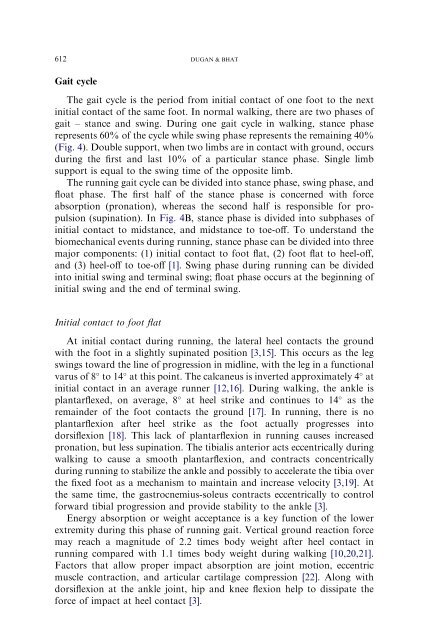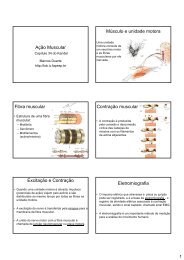Biomechanics and Analysis of Running Gait - De Motu
Biomechanics and Analysis of Running Gait - De Motu
Biomechanics and Analysis of Running Gait - De Motu
You also want an ePaper? Increase the reach of your titles
YUMPU automatically turns print PDFs into web optimized ePapers that Google loves.
612 DUGAN & BHAT<br />
<strong>Gait</strong> cycle<br />
The gait cycle is the period from initial contact <strong>of</strong> one foot to the next<br />
initial contact <strong>of</strong> the same foot. In normal walking, there are two phases <strong>of</strong><br />
gait – stance <strong>and</strong> swing. During one gait cycle in walking, stance phase<br />
represents 60% <strong>of</strong> the cycle while swing phase represents the remaining 40%<br />
(Fig. 4). Double support, when two limbs are in contact with ground, occurs<br />
during the first <strong>and</strong> last 10% <strong>of</strong> a particular stance phase. Single limb<br />
support is equal to the swing time <strong>of</strong> the opposite limb.<br />
The running gait cycle can be divided into stance phase, swing phase, <strong>and</strong><br />
float phase. The first half <strong>of</strong> the stance phase is concerned with force<br />
absorption (pronation), whereas the second half is responsible for propulsion<br />
(supination). In Fig. 4B, stance phase is divided into subphases <strong>of</strong><br />
initial contact to midstance, <strong>and</strong> midstance to toe-<strong>of</strong>f. To underst<strong>and</strong> the<br />
biomechanical events during running, stance phase can be divided into three<br />
major components: (1) initial contact to foot flat, (2) foot flat to heel-<strong>of</strong>f,<br />
<strong>and</strong> (3) heel-<strong>of</strong>f to toe-<strong>of</strong>f [1]. Swing phase during running can be divided<br />
into initial swing <strong>and</strong> terminal swing; float phase occurs at the beginning <strong>of</strong><br />
initial swing <strong>and</strong> the end <strong>of</strong> terminal swing.<br />
Initial contact to foot flat<br />
At initial contact during running, the lateral heel contacts the ground<br />
with the foot in a slightly supinated position [3,15]. This occurs as the leg<br />
swings toward the line <strong>of</strong> progression in midline, with the leg in a functional<br />
varus <strong>of</strong> 8 to 14 at this point. The calcaneus is inverted approximately 4 at<br />
initial contact in an average runner [12,16]. During walking, the ankle is<br />
plantarflexed, on average, 8 at heel strike <strong>and</strong> continues to 14 as the<br />
remainder <strong>of</strong> the foot contacts the ground [17]. In running, there is no<br />
plantarflexion after heel strike as the foot actually progresses into<br />
dorsiflexion [18]. This lack <strong>of</strong> plantarflexion in running causes increased<br />
pronation, but less supination. The tibialis anterior acts eccentrically during<br />
walking to cause a smooth plantarflexion, <strong>and</strong> contracts concentrically<br />
during running to stabilize the ankle <strong>and</strong> possibly to accelerate the tibia over<br />
the fixed foot as a mechanism to maintain <strong>and</strong> increase velocity [3,19]. At<br />
the same time, the gastrocnemius-soleus contracts eccentrically to control<br />
forward tibial progression <strong>and</strong> provide stability to the ankle [3].<br />
Energy absorption or weight acceptance is a key function <strong>of</strong> the lower<br />
extremity during this phase <strong>of</strong> running gait. Vertical ground reaction force<br />
may reach a magnitude <strong>of</strong> 2.2 times body weight after heel contact in<br />
running compared with 1.1 times body weight during walking [10,20,21].<br />
Factors that allow proper impact absorption are joint motion, eccentric<br />
muscle contraction, <strong>and</strong> articular cartilage compression [22]. Along with<br />
dorsiflexion at the ankle joint, hip <strong>and</strong> knee flexion help to dissipate the<br />
force <strong>of</strong> impact at heel contact [3].



